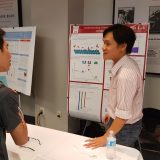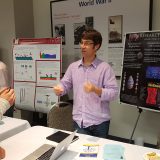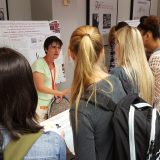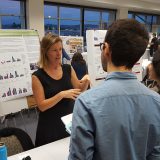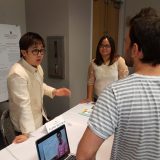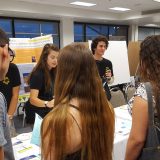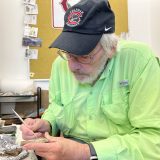Hands-on Scientific Research Opportunities for Undergraduates Schmid College professors showcase research opportunities at OURCA's 2016 Faculty Research Expo
November 11, 2016
Earlier this week, Schmid College faculty showcased their research and opportunities for students to get involved in it at the university-wide Office of Undergraduate Research and Creative Activity (OURCA) 2016 Faculty Research Expo. They were joined at the annual event by faculty from across the university in a tremendous display of the breadth of scholarly and creative activity at the university.
At the event, students were able to talk personally with each professor about her research and how they can get involved. Students attend this event each year and for many it sparks research experiences that are “the highlight of their Chapman University experience,” explains OURCA in the event brochure.
- Justin Dressel and students working with him explain their research.
- Student Thang Nguyen who works in the Cat (Catalysis) Lab explains their work.
- Students in the Wetland Biogeochemistry Lab (aka Swamp Monsters) show off their awesome shirt and (temporary) tattoos
- Bill Wright explains his lab’s research in marine invertebrate biology.
- Douglas Fudge explains his lab’s work with hagfish slime.
- Melissa Rowland-Goldsmith explains her research to a group of enthralled students.
- Jennifer Funk talks to students about her research on invasive and non-invasive plants.
- Rosalee Hellberg talks to students and faculty about her research uncovering food fraud.
- Peter Esperanza (left in white) and Cris Toto right in white) explain their work.
- Students in the Kim Environmental Geochemistry (KEG) Lab explain their work.
Are you still looking for an undergraduate research opportunity? Wondering what kinds of hands-on research experiences Schmid College faculty offer students? Check out the descriptions below and then contact the professor to inquire about open opportunities. Special thanks to OURCA Coordinator Lisa Kendrick for compiling and sharing these descriptions.
Justin Dressel, Ph.D.

Justin Dressel, Ph.D.
Overview of scholarly research/creative activity: Quantum foundations, quantum information, and quantum computing.
Specific projects working on: We are working with experimental teams at UC Berkeley, UC Santa Barbara, and Washington U to develop superconducting circuits for quantum computation. We are also working with theory teams at UC Riverside, and U Rochester to develop methods for processing stochastic microwave signals for extracting quantum information from evolving quantum bits. We have a collaboration with the experimental optics group of Dr. LaRue here at Chapman to investigate the uses of orbital angular momentum of light for catalysis, as well as for quantum information tasks. We also study purely theoretical physics, such as algebraic approaches to quantum foundations and relativistic classical fields. We are also engaged in gamifying quantum physics and creating physics demos.
Number of students looking to work with: 3-4
Time commitment for student(s): Group meetings once a week (3hrs), individual meeting once a week (1hr), and individual progress each week (as required).
When students are needed: Interterm 2017, Spring 2017, Summer 2017
What would the student be expected to do: Possible topics: math calculations, computer simulations, quantum circuit design, optical laboratory work, hands-on work creating demos.
Requirements for students who work with you: Interest in quantum physics. Ambition to learn new things quickly.
Hesham El-Askary, Ph.D.
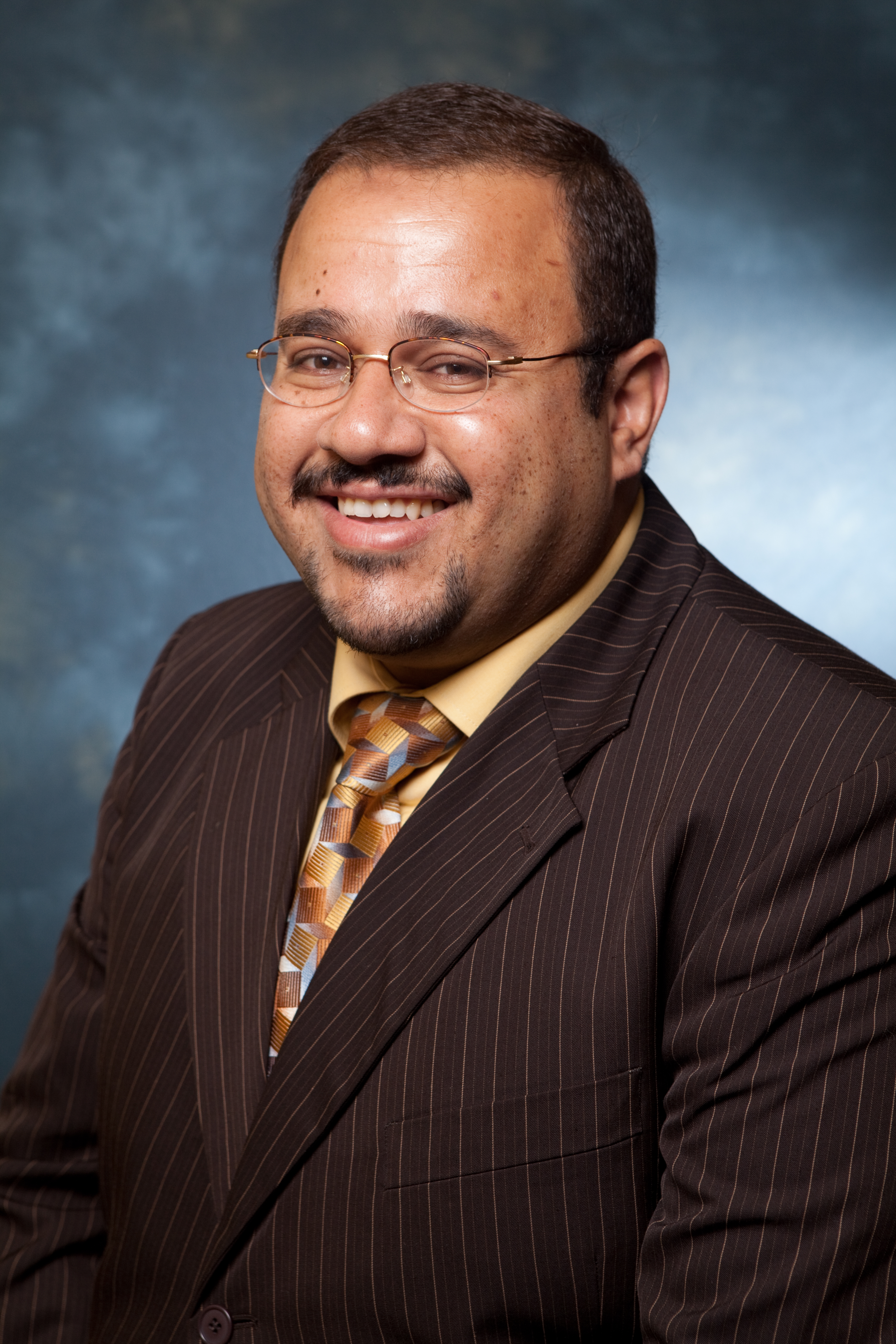
Hesham El-Askary, Ph.D.
Overview of scholarly research/creative activity: I have been particularly interested in studying natural events of global nature that does have an impact on the local scale.
Specific projects working on:
1. Studying the impact of sea level rise over low lands using ASTER Digital Elevation Model data in association with high resolution ground 3D laser scanner for validation.
2. Using many aerosol derived satellite parameters over a long time period coupled with linear genetic programming (LGP) technology for better studying (and modeling) different air pollution episodes over megacities. Such coupling will provide insight into the microphysics of the air dynamics and enhance our understanding of the role and degree of contribution or the level of impact of different atmospheric parameters under investigation.
3. Long time series analysis of meteorological, satellite and ground observations data in association with precipitation, model data and other derived indices to understand the physical mechanism between different atmospheric parameters, namely aerosols, clouds and water vapor through comprehensive approaches.
4. Inter-sensor comparison and ground validation of satellite derived indicators of pollution and climate change such as aerosols, ozone, H2O, and other gases such as NO2, CO2.
Number of students looking to work with: 1-2
Time commitment for student(s): 5 hrs/week
When students are needed: Spring 2017
What would the student be expected to do: Literature research/summary, data collection and analysis, intercomparisons.
Requirements for students who work with you: Excel and matlab as a start.
Flippin’ Math Duo
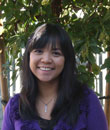
Criselda S. Toto, Ph.D.
Criselda Toto, Ph.D. and Peter Esperanza
Overview of scholarly research/creative activity: Flipped classroom model is a form of blended learning where short video lectures are delivered online for students to view in their own time while classroom instruction is devoted to discussions and active learning activities.
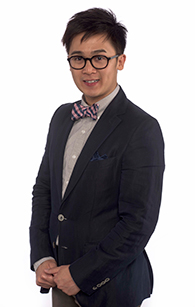
Peter Esperanza
Specific projects working on: The study adopted a randomized controlled trial to evaluate the effectiveness of the flipped classroom model. It took place in a public high school in a high desert area in California, USA. The school population is about 1,380 students comprised of 26% Caucasian, 3% Asian, 55% Hispanic, and 16% African-American students where 70.6% of students are qualified in free or reduced price lunch. The videos used in the experimental group follows production using the Fizz Method. Using this method, the videos have the following characteristic: minimal post-production, and usually completed in a single attempt; the teacher appears in the video and the notes are handwritten. The minimal post-production contributes to the simplicity of the video and easiness of video production. The talking head provides the non-verbal cues that might aid students and is also proven to be more engaging in online video formats. The handwritten notes, as McCammon explains, is a form of modelling that allows students to see their thought processes and supports understanding.
Douglas Fudge, Ph.D.
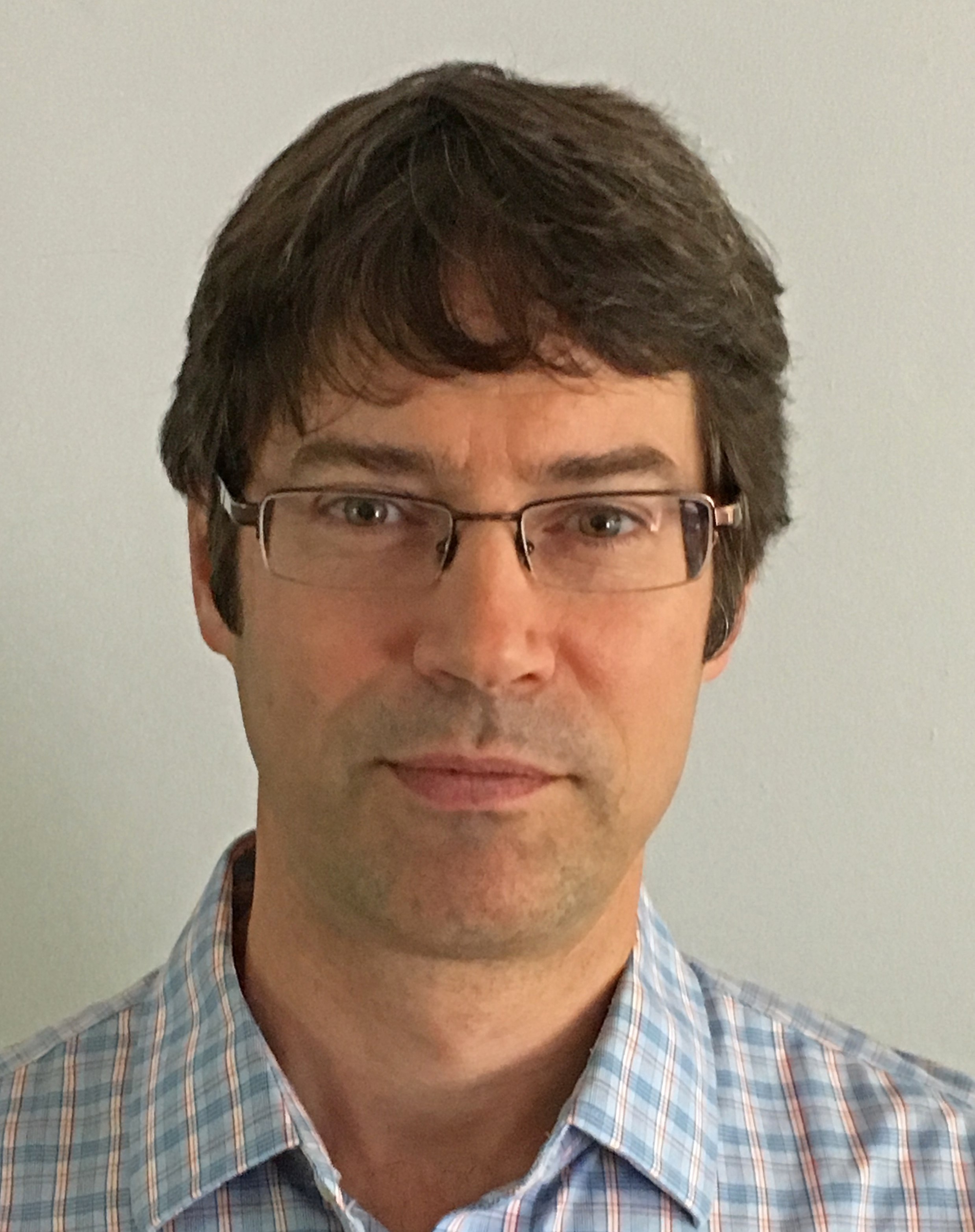 Overview of scholarly research/creative activity: Animal biomechanics and marine biology
Overview of scholarly research/creative activity: Animal biomechanics and marine biology
Specific projects working on: We study a wide range of materials made by animals, including nano-scale filaments within cells, slimes secreted to ward off predators, and large structures like the keratinous plates of baleen whales. Two new projects are aimed at figuring out how hagfish squeeze through tiny holes and how they survive shark attacks. We are also working on several biomimetics projects, which involve applying what we learn from animals to solve problems of interest to humans. These include the manufacture of high performance, eco-friendly polymers and super-absorbent materials.
Number of students looking to work with: 3-4
Time commitment for student(s): Must be enrolled in a research course – 291 or 491.
When students are needed: Interterm 2017, Spring 2017, Summer 2017
What would the student be expected to do: Lab experiments, literature research, some work in field (hagfish collection).
Requirements for students who work with you: Class level- sophomore or higher.
Jennifer Funk, Ph.D.
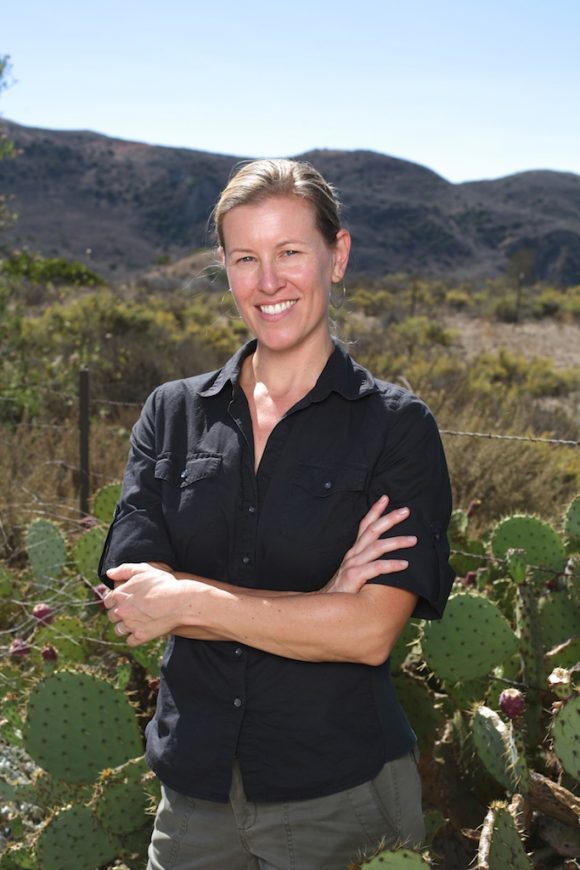
Jennifer Funk, Ph.D.
Overview of scholarly research/creative activity: Plant ecology; invasive species; restoration ecology.
Specific projects working on: Our research focuses on three research questions: How do plants respond to reduced water availability? What factors contribute to plant invasiveness? How can plant functional traits be used to restore native plant communities.
Number of students looking to work with: 1-2
Time commitment for student(s): 3 hours per week.
When students are needed: Spring 2017
What would the student be expected to do: Data collection on potted plant experiment and possibly field experiment, analyzing plant samples in the laboratory.
Requirements for students who work with you: Interest in biology or environmental science.
Rosalee Hellberg, Ph.D.
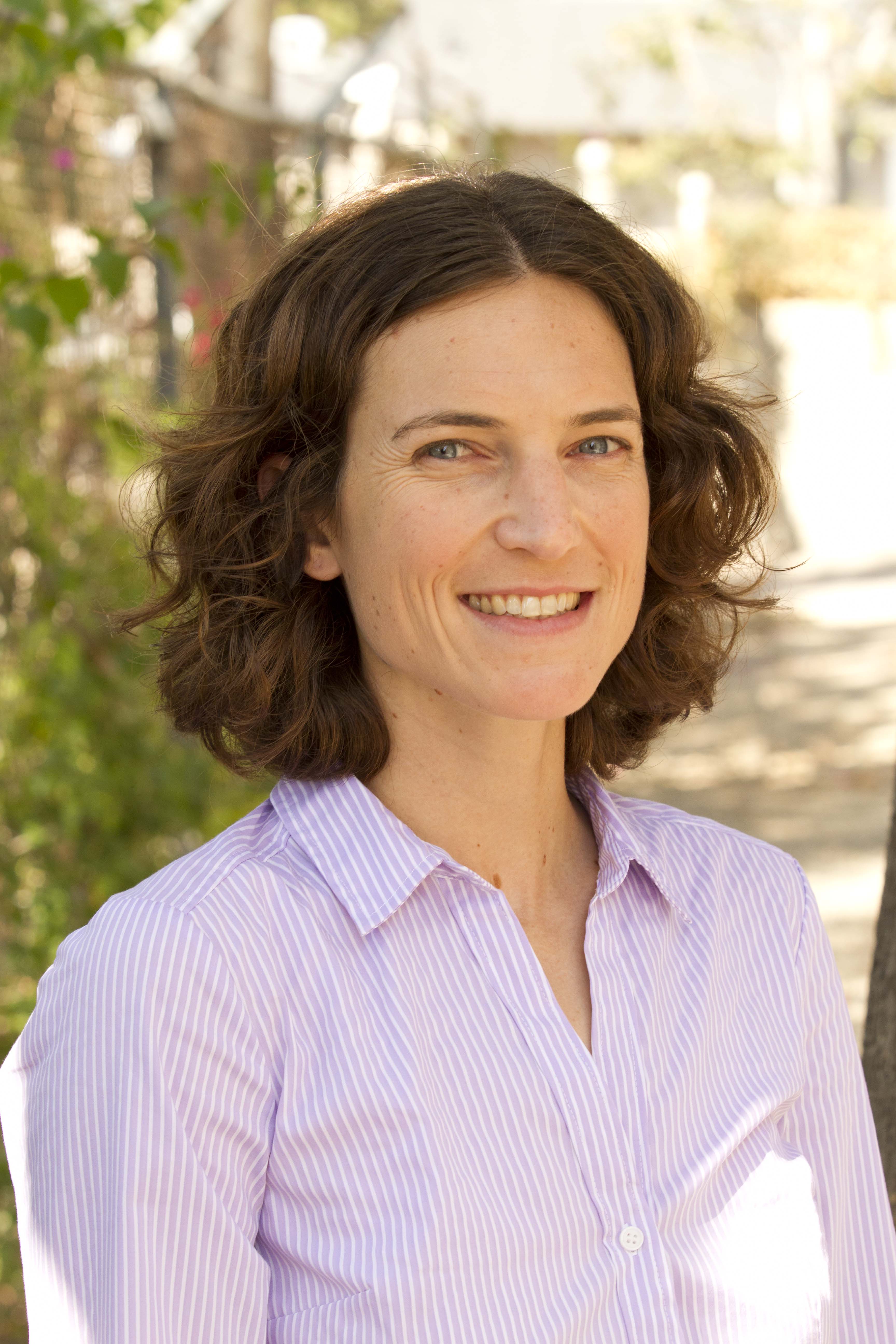
Rosalee Hellberg, Ph.D.
Overview of scholarly research/creative activity: My research is focused on food safety and mislabeling. Within food safety, I work on the development and application of rapid methods to identify foodborne pathogens. In my research into food mislabeling, I develop and apply molecular methods to identify instances of species substitution or misbranding in a variety of food items.
Specific projects working on: Specific projects underway include the application of DNA-based methods to identify species in commercial shark products and catfish products; use of ELISA for the detection of mycotoxins in pet foods; whole-genome sequencing of noroviruses; and development of a method to increase the sensitivity of detection for Listeria in foods.
Number of students looking to work with: 1-2
Time commitment for student(s): 10-30 hours per week; meet once/week
When students are needed: Spring 2017, Summer 2017
What would the student be expected to do: Lab experiments, experimental design and planning.
Requirements for students who work with you: Completed basic science courses.
Christopher Kim, Ph.D.

Christopher Kim, Ph.D.
Overview of scholarly research/creative activity: The Kim Environmental Geochemistry (KEG) Lab studies the chemistry of geological processes that have environmental impacts. Students conduct hands-on lab experimentation, data analysis, and trips to a X-ray facility at Stanford University for sample analysis. Self-learners working independently in a supportive group setting desired!
Specific projects working on:
1. Nanoparticle aggregation and metal adsorption/desorption: iron oxyhydroxide nanoparticles are made in our lab, aggregated to varying extents under different solution conditions, and then exposed to dissolved metals to examine how well they adsorb and retain these metals. Direct applications to the treatment and remediation of contaminated waters can result from this work.
2. Arsenic contamination in abandoned gold mines throughout California: students help measure trends in concentration, distribution, and speciation of arsenic in mine wastes as a function of particle size and weathering.
3. Arsenic bioaccessibility/bioavailability in mine wastes: this involves conducting leach extraction tests designed to simulate the ingestion or inhalation of fine-grained mine waste particles, with correlations to toxicity in humans and other animals.
Number of students looking to work with: 3-4
Time commitment for student(s): One 20-minute meeting a week, usually on Monday morning, minimum 4 hours of work in the lab during the week, 1 hour lab group meeting towards the end of the week, participation in University Research Day at the end of the semester.
When students are needed: Fall 2016, Interterm 2017, Spring 2017, Summer 2017
What would the student be expected to do: Students take part in every aspect of research in the lab, including: literature review and presentation, design/refinement of experimental protocol, conducting experiments, analyzing and processing data, presenting work at group meetings and possibly conferences.
Requirements for students who work with you: First year chemistry (CHEM 140/150), Moderate proficiency in Microsoft Excel, Ability to fulfill time commitment expectations (see below), Room in schedule to enroll in 2-3 units of CHEM291/491 or ENV291/491 (academic year only; I can pay for summer research assistants).
Jerry LaRue, Ph.D.
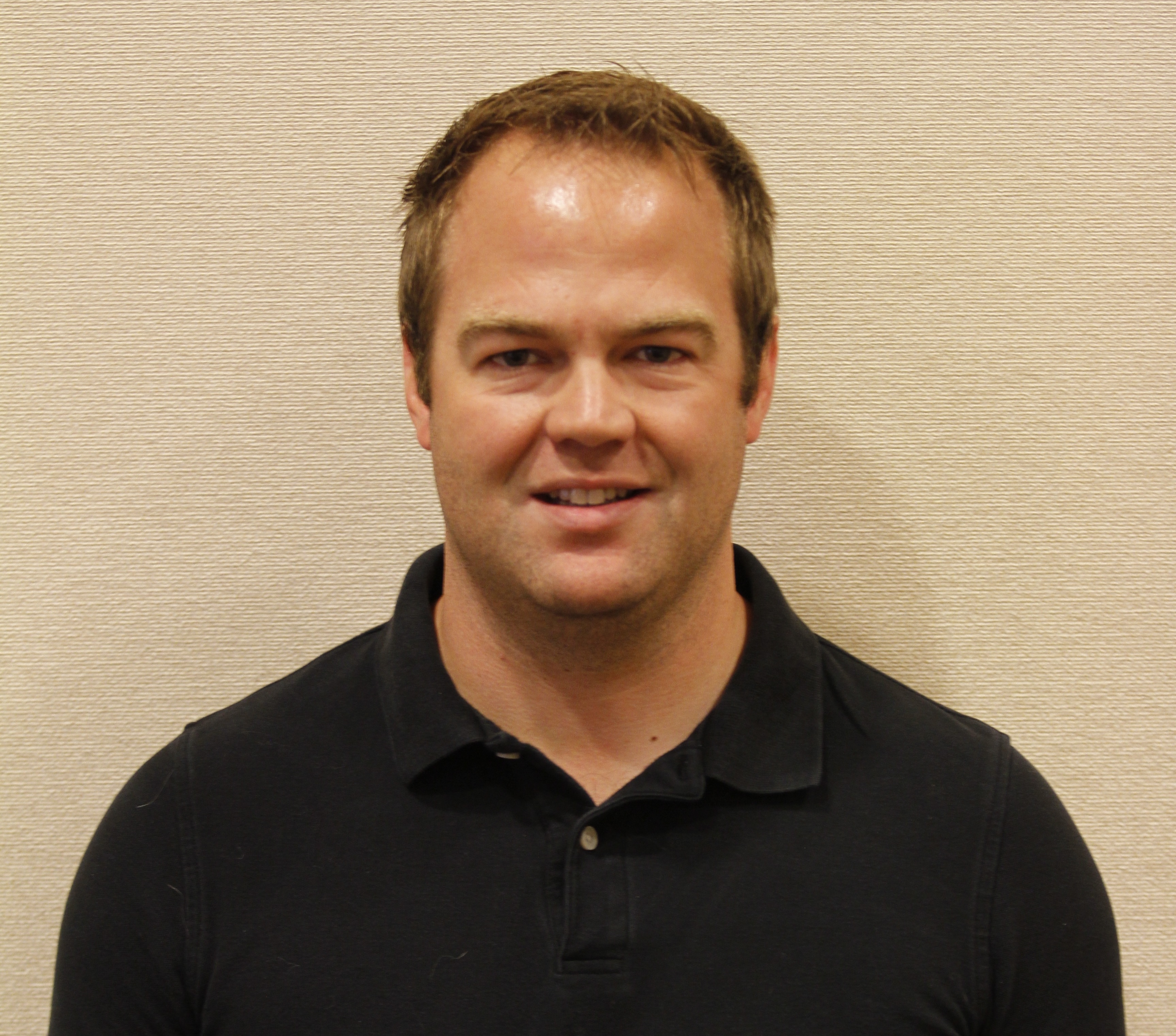
Jerry LaRue, Ph.D.
Overview of scholarly research/creative activity: The Catalysis Research Lab (CatLab) aims to use laser spectroscopy to better understand chemical reactions on the most fundamental level.
Specific projects working on: We are interested in studying reactions that are important to society, such as clean carbon-to-fuel transformation (Fischer-Tropsch process) and ammonia production (Haber-Bosch process) for use in fertilizers.
Number of students looking to work with: 3-4
Time commitment for student(s): Meet once a week with 3 – 6 hours commitment to the project per week.
When students are needed: Fall 2016, Interterm 2017, Spring 2017, Summer 2017
What would the student be expected to do: Designing and carrying out experiments.
Requirements for students who work with you: Completed first year of general chemistry.
Melissa Rowland-Goldsmith, Ph.D.

Melissa Rowland-Goldsmith, Ph.D.
Overview of scholarly research/creative activity: My lab utilizes molecular biology techniques to study the molecular mechanism of pancreatic cancer cell inhibition when treated with various agents including pomegranate juice extract and caffeine.
Specific projects working on: Currently we are studying how the combination treatment inhibits cancer cell migration by studying specific genes coding for proteins involved in the epithelial to mesenchymal transition (EMT). We are using both qRT PCR and immunoblot techniques to study the mRNA and protein levels.
Wetland Biogeochemistry Lab
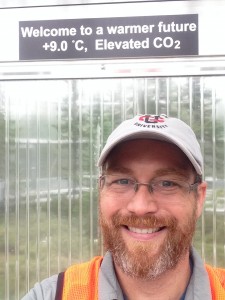
Jason Keller, Ph.D.
Jason Keller and Cassandra Medvedeff
Overview of scholarly research/creative activity: Research in the Wetland Biogeochemistry Laboratory explores the relationship between wetland carbon cycling and global change. We work on projects related to soil carbon storage and greenhouse gas fluxes in wetlands ranging from salt marshes in California to northern peatlands in Minnesota.
Specific projects working on: Research in our laboratory focuses on 3 themes.
Theme 1 – Anaerobic microbial decomposition in peatlands. Microbial decomposition of organic matter in anaerobic wetland soils is mediated by a number of microbial processes that ultimately produce CO2 and CH4. We are exploring the mechanistic controls of these processes in wetland soils. Many of our projects investigate the importance of the novel microbial processes – including organic matter reduction and methylotrophic methanogenesis – in peatland ecosystems.
Theme 2 – The response of wetlands to global change. Wetlands store one-third of the terrestrial soil carbon and release globally significant amounts of the potent greenhouse gas CH4 to the atmosphere. Understanding the stability of wetland soil carbon and the response of wetland CH4 flux to global change has important implications in the context of the global climate. We are working on a large climate change experiment that simulates warming and elevated atmospheric CO2 in a northern Minnesota bog.
Theme 3 – Coastal blue carbon. Conceptually, the carbon stored in the soils of coastal wetlands – blue carbon – could be traded on emerging carbon markets to generate a revenue stream for wetland conservation and restoration projects. We are working to quantify greenhouse gas fluxes from blue carbon projects in California.
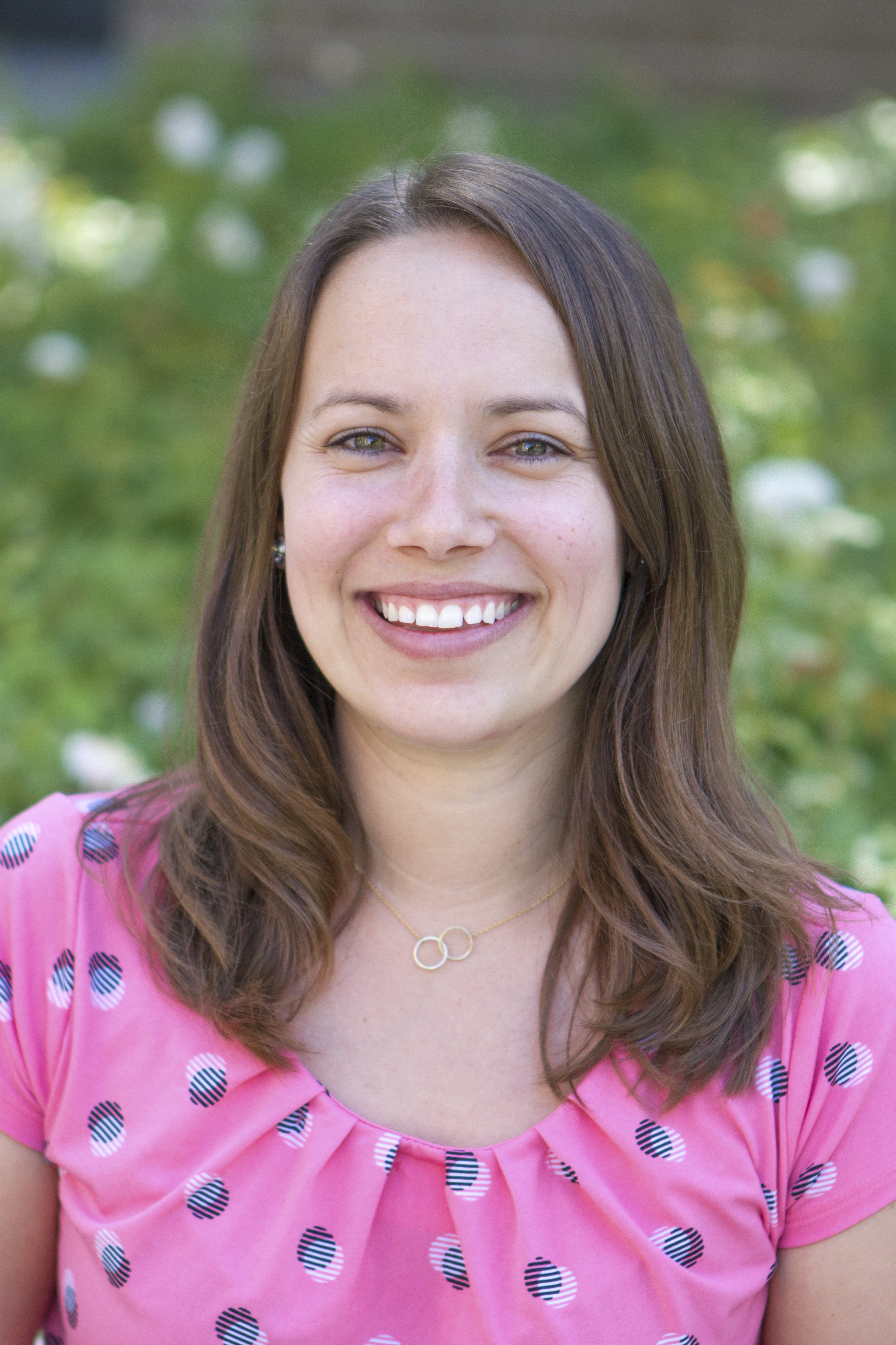
Cassandra Medvedeff, Ph.D.
Number of students looking to work with: 1-2
Time commitment for student(s): Students should be prepared to spend between 4-10 hours per week on research (depending on the particular project). This will include a mandatory weekly laboratory meeting (1 hour) for the entire research team. In general, larger blocks of time for research are preferred.
When students are needed: Spring 2017
What would the student be expected to do: Most of our ongoing projects involve primarily laboratory work. This includes the setup of experiments, the analysis of gas and water samples, data summary and analysis, and the associated routine laboratory maintenance. There are periodically opportunities for field work on some projects. Students also participate in weekly laboratory meetings where they present papers from the primary literature, share progress updates on their projects and provide feedback on projects being presented by their peers.
Requirements for students who work with you: Most importantly, students need to be able to work well in a research team that includes undergraduate researchers, research technicians and faculty. We expect students to take ownership of their projects and to work carefully and professionally when collecting, analyzing and communicating data and results. The most successful students in our research team have a passion for environmental research. Interested students should have course work in biology, chemistry, ecology and/or environmental science. Careful attention to detail and an ability to follow laboratory protocols are necessary. Students are required to maintain laboratory notebooks and manage data in Microsoft Excel.
William G. Wright, Ph.D.
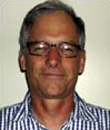
William Wright, Ph.D.
Overview of scholarly research/creative activity: Neurobiology, ecology, and evolution of behavior in marine invertebrates.
Specific projects working on: Evolution of learning and memory. We are testing a mechanistic hypothesis for the evolutionary loss of learning in a single species of sea hare (a marine slug). We are also testing with field experiments the idea that this sea hare’s ecology is extremely specialized for a predator-free niche, perhaps to compensate for its loss of the learning phenotype. Ecology of dislodgement in an intertidal limpet. The large owl limpet, Lottia gigantea, defends a territory with strong thrusts and rapid chase behavior. We have been examining how this aggressive behavior increases the danger of dislodgement for both intruder and resident. We are also exploring the ecological consequences of dislodgement. Effects of global climate change on behavior.
1.) Heat: (a.) Do heat spells compromise the “landscape engineer” role of a Lottia gigantea? Field (and planned laboratory) studies document how its territorial behavior is compromised by temperature. (b.) Do physiological responses to heat shock correlate with behavioral responses. Experiments with an intertidal hermit crab finds surprising negative correlations that remain to be understood!
2.) Ocean acidification: Does ocean acidification create an unprecedented olfactory “cloak of invisibility”, thereby making prey extremely vulnerable? Our recent experiments with hermit crabs and their predators have documented a striking compromise of anti-predator activity by ocean acidification.
Number of students looking to work with: 3-4
Time commitment for student(s): 1 h meeting per week, 8 hours individual research.
When students are needed: Spring 2017
What would the student be expected to do: Lab and field observations.
Requirements for students who work with you: Minimum 9 hours per week.
Peiyi Zhao, Ph.D.
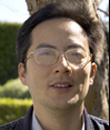
Peiyi Zhao, Ph.D.
Overview of scholarly research/creative activity: My research area is low power integrated circuits for processors in laptop, desktop, and servers in data centers.
Specific projects working on: To satisfy the exploding needs of Big Data and Cloud Computing, the number of data centers has been significantly growing. However, data centers worldwide have consumed massive amount of energy. World’s 1 billion Personal Computers are on for 9 hours per day requiring 95,000 Mega-Watts, which is equivalent to about 100 large coal-fired power stations. Clocking system power dissipation accounts for 30%-50% of the overall power consumption of the processor. My main research is low power flip flop design for clocking system. Currently I am working on clock gating technique to reduce power consumption of processors. Using this technique, when input does not change, the clocking elements will keep idle to save power.
Number of students looking to work with: 1-2
Time commitment for student(s): 2 hour /per week
When students are needed: Spring 2017
What would the student be expected to do: Draw layout of circuit, measure power, speed using simulation tool.
Requirements for students who work with you: Completed CPSC330, Digital Logic Design.
Center of Excellence in Earth Systems Modeling and Observations (CEESMO)
Menas Kafatos, Seung Hee Kim and Nikolaos Hatzopoulos
Overview of scholarly research/creative activity: The Center of Excellence in Earth Systems Modeling & Observations (CEESMO) is an interdisciplinary research unit. The Center focuses on observations of the Earth and modeling and analyzing the Earth systems with particular emphasis on natural hazard and climate change impact studies.
Specific projects working on: Agroecosystem Study We have utilized multiple regional models (climate, crop and ecosystem) to capture climate impacts at regional agroecosystem in the Southwestern U.S (SWUS). Also, we have conducted research on the relationship between daily temperatures in SWUS and various large-scale climate phenomena (NAO, ENSO, PDO and AMO). Water resource Study Mountain snowpack plays a critical role for the watercycle in SWUS thus snowpack variability is very important to assess water resource in CA especially under multi-year consequtive drought condition. We have conducted research on the relationship between the climate variability and snowmelt in SWUS. Wildfire Study Live Fuel Moisture (LFM) is a measure of dryness which is used from the fire departments to determine the critical level of dryness in semi-arid forest regions. Our research study focuses on mapping LFM using remote sensing data from satellites and studying the interanual spatial response of LFM with ultimate goal to identify major drivers of wildfire events. Other Studies Director Dr. Kafatos is conducting research on mathematical frameworks to address the issues of qualia and conscious awareness. Such approaches are consistent with quantum mechanical views of the role of observation. Moreover, a recent co-authored paper is examining certain retrocausal quantum eraser experiments, with collapse of the wave function, giving experimental interpretation of a ubiquitous observer.
Number of students looking to work with: 1-2
When students are needed: Interterm 2017, Spring 2017, Summer 2017
What would the student be expected to do: Statistical analysis, data processing, and simple programming.
Requirements for students who work with you: Be skilled in coding (Python, Fortran, Matlab, C++, etc.).
Schmid College extends its sincere thanks to the Office of Undergraduate Research and Creative Activity for hosting another excellent Faculty research Expo. Every year, this event helps Chapman University students to connect directly with professors and understand the breadth of opportunity available to them.


